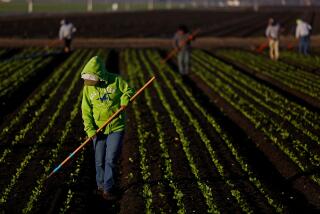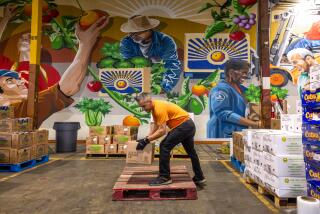Cuba’s family farms grow again
- Share via
ALTAHABANA, CUBA — Speckled chickens in Geraldo Pinera’s garden will be on his family’s dinner table soon, stewed with herbs and tomatoes and garnished with creamy slices of the avocados now ripening on a pair of spindly trees.
Pinera, a member of a 25-family farming cooperative in this village outside Havana, tends a private half-acre plot tucked between the state-owned mango orchards where he works a day job. He raises guava, passion fruit, sweet potatoes and poultry to augment a $20 monthly income and the government ration of starches.
Like other Cuban families, the Pineras are eating more fruits and vegetables as a result of a national campaign to boost food output and curb costly imports. Their efforts represent a small but significant step toward the government’s ultimate goal to vastly reduce its dependence on more efficient foreign producers, especially for favorite foods such as rice, meat and dairy.
President Raul Castro spurred the planting of idle lands around cities with a series of reforms in recent months aimed at improving self-sufficiency. The moves included making land available free to those willing to till it and easing a strangling national bureaucracy that once controlled a farmer’s every step, from seed procurement to sales price.
Castro has unleashed an ambitious effort to lift output of high-ticket items, raising prices paid to meat and milk producers and freeing growers from obligations to sell their food to the state.
He has made seeds, tools and fertilizers available through a new network of country stores and challenged a population that is 80% urban to grow what it eats.
But a swift expansion in meat and dairy production remains a daunting task, as few farming co-ops have money to pay for cattle even when the prices for their products are increasingly enticing. Predictions of quick results appear to echo the excess ambition of the failed drive in 1970 to harvest 10 million tons of sugar and the unfulfilled plans of past decades to provide each family with its own milk cow.
The government expects to cut food imports by at least 5% next year, Deputy Agriculture Minister Juan Perez Lama told journalists in Havana in early June. He also predicted that rice imports could be halved within five years -- a herculean task considering that Cuba last year imported $170 million worth from Vietnam, China and the United States.
Cuban state enterprises grew about 10% of the 700,000 tons of rice consumed last year. Private farmers produced about twice that. Although 70% has to be imported, scholars point to the rise in the small-farm output begun a decade ago.
“It’s an impressive goal [to halve rice imports] but I do think Cuba is in a unique position to achieve it,” said Catherine Murphy, a San Francisco Bay Area sociologist working on development projects in Latin America.
Murphy lived in Havana during the late 1990s, when the country suffered severe food shortages after the loss of Soviet aid. That experience of having to swiftly replace imports is serving Cubans well now that food prices are rising around the world, she said.
The state food trade agency, Alimport, reported that rice costs had tripled this year.
In announcing cuts in public investments because of high fuel and food prices, Vice President Carlos Lage predicted that imported food would cost the government at least 50% more this year than last, when it spent $1.7 billion.
Cuba spent almost 30% more on food imports from the United States last year than in 2006, but that increase was due to rising costs, not quantity, said John Kavulich, senior policy advisor of the U.S.-Cuba Trade and Economic Council in New York.
The United States has imposed a trade embargo on Cuba for decades. Food and medicine sales have been allowed in recent years, but prohibitive shipping and payment regulations still prevent Cubans from taking full advantage of their nearest market.
Dairy output has been slumping since the early 1990s, “fundamentally due to very low investment by the dairy cooperatives, for either keeping their herds or pastures in good shape,” said Frederick Royce, a University of Florida researcher who did graduate work in Cuban agriculture in the mid-1990s.
Until recently, he added, the set price the government paid farmers for milk was well below its cost of production.
In May, farmers who gathered in Havana for a meeting on organic and sustainable agriculture spoke of the need for ingenuity and doing more with less. Such skills were needed in the years after the Soviet trade bloc collapse, referred to as the Special Period in Peacetime, which generated nationwide deprivation.
The outlook for small-scale organic farming has patriotic agronomists like Victor Cruz, a retired army colonel working 50 acres in a rural enclave just south of Havana, predicting victory over the economic blockade imposed by the United States.
“We will succeed in growing our own food because we have the spirit of the revolution driving us,” he said. “We were hungry during the Special Period, but we learned a lesson about dependence.”
Raul Castro, then defense minister under older brother Fidel’s leadership, spearheaded that recovery effort in the mid-1990s, deploying troops to the fields to plant, tend and harvest. Daily calorie intake dropped by a quarter during that time and the average Cuban lost more than 20 pounds before domestic production picked up.
Cuban agriculture had been backsliding again since 2004, when Fidel Castro halved sugar cane growing and milling amid a global slump in sugar prices. He also restored limits on the sale of privately grown produce in an effort to prevent what he considered farmers’ exploitation of urban compatriots.
The government also failed to fulfill promises of better housing for many of the large farming cooperatives in remote rural areas, which have traditionally operated with much less efficiency than the urban and suburban patches that have ready access to buyers.
Along the gravel road leading to the mango co-op, women such as Catalina Alfonso display their produce in battered wheelbarrows for passing motorists and pedestrians.
“I make hardly anything because most of what we grow we need for ourselves,” Alfonso said. “But at least we are eating better nowadays.”
Alfonso’s neighbor, Carmen Martino, like many Cubans, disputed whether more fruits and vegetables represented an improvement.
“We Cubans eat rice, beans and meat. We have since colonial times,” Martino said with a defiant bob of her head that jangled her gold earrings, hoops encircling the word “love.” “I know fruits and vegetables are healthier, but no one will get us to change our ways.”
--
More to Read
Sign up for Essential California
The most important California stories and recommendations in your inbox every morning.
You may occasionally receive promotional content from the Los Angeles Times.











